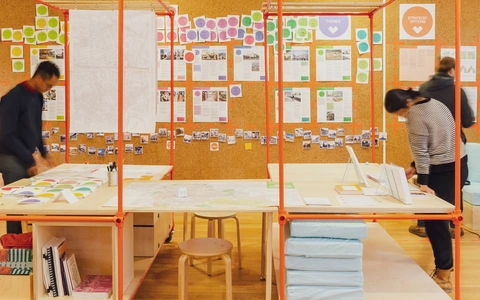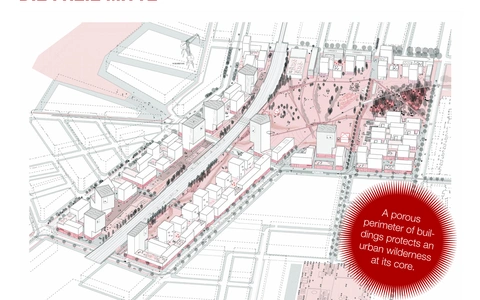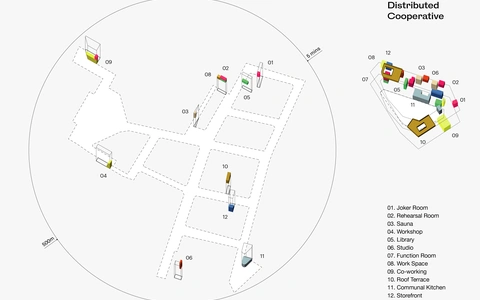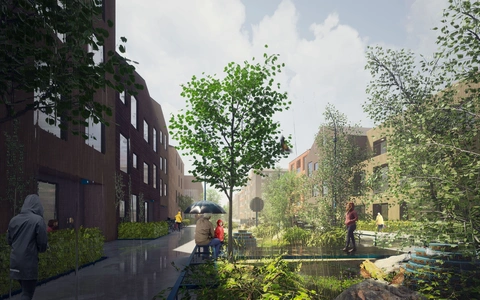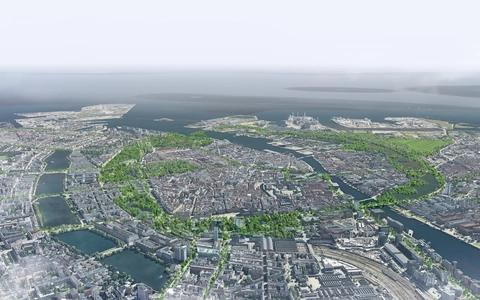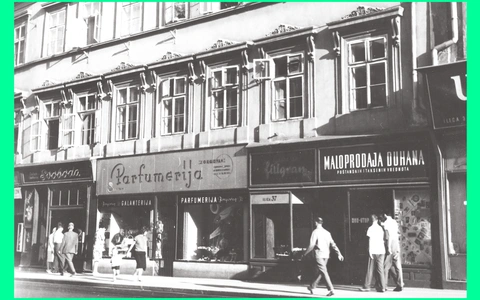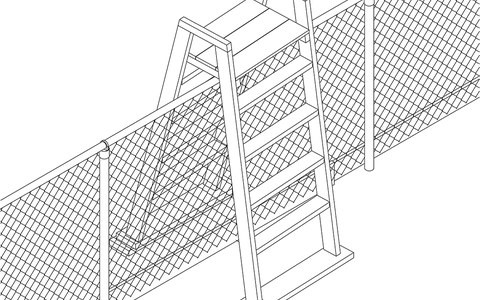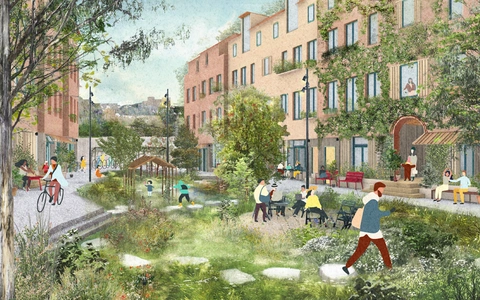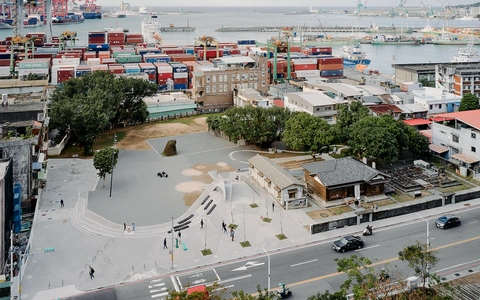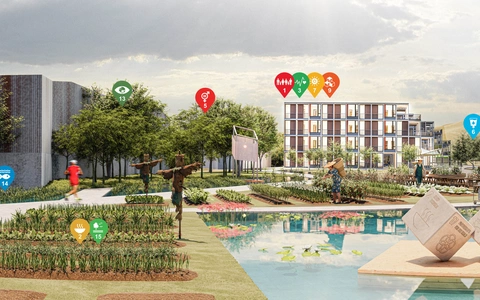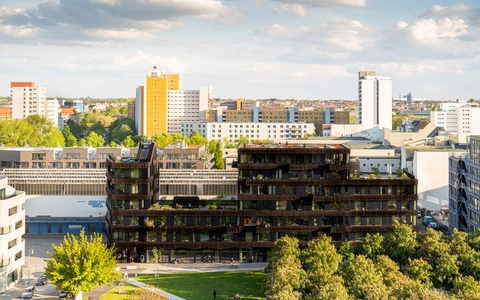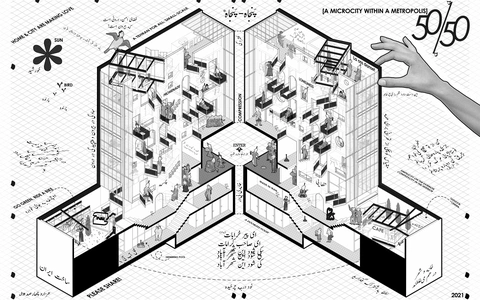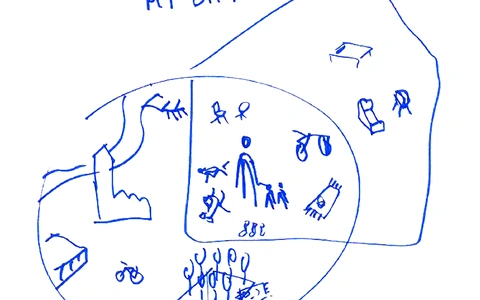Jury statement
We received 383 complete submissions from architects, planners, urban practitioners, academics, artists, activists and others from around the world. We, the jury, are excited to announce the six submissions selected for exhibition at the Triennale 2022, as well as seven honourable mentions.
The submissions showed a wide variety of urban planning and architectural projects, urban practices and academic and artistic perspectives. We are especially happy to see many submissions displaying creativity in both (architectural) form and (cultural, social) content contributing to more diverse, generous and sustainable neighbourhoods.
All in all – an impressive demonstration of neighbourhood engagement and thinking. 236 submissions have been selected for online exhibition at the Neighbourhood Index.
We would like to thank all submitters for the effort invested in the work, and we hope you will take the time to explore the ventures into neighbourhood projects and practices.
The jury:
- Matevž Čelik, founder and program director, LINA
- Camilla van Deurs, City Architect of Copenhagen
- Francesco Garutti, curator at the Canadian Centre for Architecture
- Jenny B. Osuldsen, partner Snøhetta, professor landscape architecture NMBU
- Christian Pagh, Director and Chief curator, The Oslo Architecture Triennale (Jury Lead).
"Neighbourhoods are vital to our urban communities. The many contributions to the Oslo Triennale show the faceted ways we can work to reimagine what great neighbourhoods are and how we can ensure that they are environmentally just, sustainable and equitable, ensuring vitality and a thriving planet for generations to come as well as a place to call home. I am truly inspired by the many projects from all over the world."— Camilla van Deurs, City Architect of Copenhagen
Selected for exhibition
The following six projects are invited to exhibit at the Oslo Architecture Triennale 2022:
Croydon Urban Room by Croydon Placemaking
Croyden Urban Room is a remarkable example of both deep and engaging public participation design. Croyden Urban Room manages to de-institutionalise bureaucratic processes, democratising access and understanding of planning through learning and open dialogue. The clear design and the ability to engage with people where they are, inspires in times where the ideals of participation struggle to be realised. It shows how continuous discussions and actions can contribute to real, valuable placemaking - as opposed to random development projects appearing from nowhere. Enabling genuine and constructive participation is challenging, and Croyden Placemaking reminds us of the value of well designed and well executed public dialogue tools.FREIE MITTE, VIELSEITIGER RAND Ongoing Process of Implementation, Vienna by StudioVlayStreeruwitz
The Freie Mitte is an inspiring act of co-design: natural forces had transformed an abandoned 11ha site in the historical heart of Vienna into a wild landscape. Rather than filling up the site, StudioVlayStreeruwitzs proposal made the wild habitat a public space, pushing new development to the edge of the site. Launched 10 years before the climate crisis became (more) mainstream in urban planning, Freie Mitte demonstrates a groundbreaking shift of paradigm: it connects the uncivilised richness of transhuman ecologies with new forms of social inclusion and community. StudioVlayStreeruwitz inspires us to rethink familiar figures of public space and the resources we invest in them and imagine wilder, more organic and shared platforms of togetherness.The Distributed Cooperative by Scott Lloyd (TEN Studio) & Alexis Kalagas
The Distributed Collective offers a conceptuel, yet pragmatic strategy to bring to use centrally located ‘odd lots’ in cities as shared functions on a neighbourhood scale. Amenities we know from cooperatives such as communal eating spaces, co-working facilities or libraries are shared with neighbours within walking distance. Redrawing the boundaries of domestic space, the project rethinks how shared use of space and functions can contribute to neighbourhood life and inclusive urban communities. Making cooperatives an alternative ‘urban interface’, Scott Lloyd (TEN Studio) & Alexis Kalagas connect urban governance systems and localised investment flows to enable citizens to imagine and prototype alternative futures. Based on co-ownership and the use of digital tools, the model represents a promising alternative to speculative housing construction.THREADS OF THE PUBLIC REALM. Streetscape scenarios for Reykjavík’s model neighbourhood by MANDAWORKS
Threads of the public realm is a well formed collection of design guidelines supporting the municipality of Reykjavik ambitions to steer the quality of a new car-reduced district. Mandaworks detail a selection of solutions to ensure biodiversity, resiliency and high-quality urban spaces, focusing on treatment of the publicly owned spaces between the buildings - the park, square and the streets. Breaking away from the traditional linear street the collection creates a variety of spaces that supports neighbourhood life through everyday experience of spontaneous encounters. Not only is the catalogue very convincing in terms of design, it’s also important as a tool for future governance for the city administration. The project presents a model of how to combine the integration of nature into the city, with a concern for the long team quality of the living environment."The immense work displayed in the open call demonstrates a passion across disciplines to engage with our urban environments with more empathy, nuance and sense of community. I am glad to see so many projects that deal with very profane aspects of our everyday lives as well as more visionary and experimental approaches. Forming more thriving neighbourhoods, communities and natural habitats in our cities requires the ability to bridge systems thinking and design skills, cultural sensibility and value perspectives. Some of the best projects indeed manage to do just this."— Christian Pagh, Director and Chief curator, The Oslo Architecture Triennale
Copenhagen Car-free(dom) by JAJA Architects
Copenhagen Far Free(dom) offers a truly inspiring vision for Copenhagen that is both pragmatic and engaging. The mobility strategy, based on a concept of ‘traffic islands’ does not prevent car access within Copenhagen, but merely prioritises pedestrians, cyclists, and public transport over cars in a series of convincing solutions. The cohesive mobility strategy for the city makes soft traffic the easiest and most attractive mode of transportation. Through a list of good examples JAJA architects also demonstrates the enormous potential for creating neighbourhood quality in streets otherwise (mis)used for traffic and parking.Project Ilica by Art and Design Collective Oaza
Project Ilica is a collaborative initiative that addresses the disappearing traditional crafts and shops in Zagreb’s main street Ilica. We were impressed with the deep reading of a street’s life - and the dedication to support local production and learning communities. The Project Ilica offers rich documentation of what shops can contain in terms of knowledge and skill, while also being an inspiring attempt to breathe new life into this multifaceted world of production. In the project, Art and Design Collective Oaza establishes a co-creation model where knowledge and skills are exchanged between craftspeople, designers and local residents. Thus, the project shows that we can collectively act to challenge the standard model of chain shops and support local craftsmanship, contributing to the diversity and authenticity of urban life."The energy from the statements and projects are inspiring and illustrate inspiring solutions for more sustainable neighbourhoods. At the same time, the contextual understanding and site specificness show the necessity of the diversity of solutions that give important input for a broader understanding of a neighbourhood."— Jenny B. Osuldsen, partner Snøhetta, professor landscape architecture NMBU
Honourable mentions
The following seven projects receive honourable mention and are thus featured projects at the Neighbourhood Index:
a fence and a ladder: subversive acts of everyday urbanism at home by Stephanie Davidson / DAVIDSON RAFAILIDIS
A fence and a ladder examines the power of an informal, spontaneous, low-tech spatial gesture: a ladder built to straddle a fence between two properties. The ladder was built to give children in neighbouring backyards a way to traverse the boundary easily, without the risk of falling. In all its simplicity - photographically well documented by Stephanie Davidson - the ladder comes out as a subversive example of “everyday urbanism”, reminding us of our habits (not jumping the fence) and potential agency (we could do just that!). The neighbourhood is also up for our own acts of expansion.The Phoenix Project by Human Nature
The Phoenix project promises the development of a new neighbourhood as an alternative to the planning norm in the UK, not only by moving away from the reliance on private cars. The project seeks to demonstrate that sustainable materials can be used at scale, that developments can increase biodiversity and that there is a real appetite for places that enable easy, communal and low-impact lives. The plan, developed through a cohesive process, features car-sharing, on-site recycling, composting, urban farming and other waste management facilities. If all these promising ambitions are turned into reality by Human Nature, it will indeed be an achievement for more ambitious neighbourhood thinking - and doing - in the UK and beyond.Keelung Sino-French War Memorial Compound public space by BIAS Architects & Associates
The Keelung Sino-French War Memorial Compound forms a public space and neighbourhood heart from a palimpsest of urban development. The project is based on an intense mix of socially relevant functions and spaces, elaborating on and reinterpreting existing resources. The design from BIAS Architects & Associates balances spatial continuity and gathering areas, facilitating the coexistence of residents' lives and the activities of the people from the neighbourhood and beyond. We appreciate how the project demonstrates an unusual urban redevelopment procedure that supports a continuous adjustment and slow expansion of the site. It showcases the possibility of a non-gentrified mix of heritage and daily life that is inspirational in both process and result. And it demonstrates how to build a culture of public space, involving a wide range of stakeholders.STEPS Eco-Village Transitional Housing by Common Ground Design
The STEPS-project aims to build community resilience, offering neighbourhood wellbeing in a temporary affordable rental housing in a semi-urban environment. The plan and design concept focuses on promoting neighbourhood interactions. Within each block, corridors serve as extensions to flats encouraging interaction, while stepped terraces at the end of corridors add informal event space, encouraging informal interactions amongst residents. The transitional housing model can serve as a temporary home for home-seekers, students, refugees and others outside the market, offering an attractive, cheap alternative to the housing conditions in Hong Kong and elsewhere."The open call and response of the Oslo Architecture Triennale showed that the neighbourhood is a highly relevant topic. I was positively surprised by the sheer number and quality of the projects received, but it was particularly good to see the wide range of projects, from self-directed plans and interventions, to masterplans, innovative proposals for the development of shared social infrastructure, for the integration of nature into the built environment, for the revitalisation of old crafts as a means of preserving knowledge, and many more. The projects bring many much-needed considerations for the future development of cities."— Matevž Čelik, founder and program director, LINA
Frizz23 – Germany’s first Baugruppe co-operative for cultural commercial space. by Deadline Architects
As Germany’s first Baugruppe cooperative for cultural commercial space, Frizz23 connects with the neighbourhood in unusual ways. Deadline Architects adapted the Baugruppe model to create workspaces for arts, education and creative industries with a group of local actors in Berlin, threatened by gentrification. Winning a public concept-based tender, Frizz23 features a rich participatory process and approach to community-focused urban development. As a result, the building is perceived as a resource in the community and hosts functions that have incubated in the neighbourhood.50/50: “A Microcity within a Metropolis” or, “How to share a living in a neighborhood?” by ABARMARZ [super-border]/Elaheh Moradi/Hossein Khorassani
50/50 explores a more social way of living, where the building block forms around shared functions such as kitchens, living rooms, laundry and gym. Co-working space, workshops, café, and public spaces on different levels are neighbourhood functions injected into the residential program. The line between the house and the city is blurred, creating a microcity within the metropolis of Tehran. Beautifully illustrated, ABARMARZ explores how to provide more attractive, sustainable and affordable housing by sharing with the neighbourhood.Transformative Densification by 51N4E
The Transformative Densification practice explores housing in a series of architecture and research projects. Their work shows how building elements, large and small, all matter and sheds light on how corridors, staircases, terraces and gardens can be more than the limit of the home. Design choices can shape collectivities as well as empower individuals and build a sense of belonging and care. 51N4E shows the value of creating alliances, including policymakers, users, researchers and developers in their attempt to develop more diverse, generous and socially aware housing."Among the very diverse contributions received I've been fascinated by those which – at different scales, and from different perspectives and geographies – tried to propose ideas and solutions to structurally re-define the idea itself of neighbourhood as urban, natural and social entity. Some of the most interesting works submitted expose the more and more urgent need to start rethinking some of the rules and the conditions – in terms of law, governance and policy making – within which practitioners are invited to operate. Reviewing the whole bulk of proposals exploring today the form of the community space has been revealing."— Francesco Garutti, curator contemporary architecture at the Canadian Centre for Architecture, Montreal
